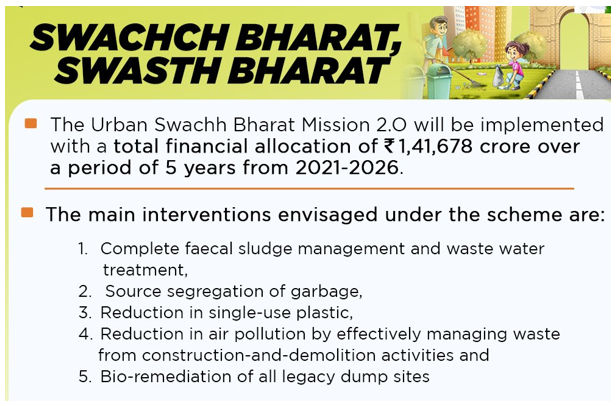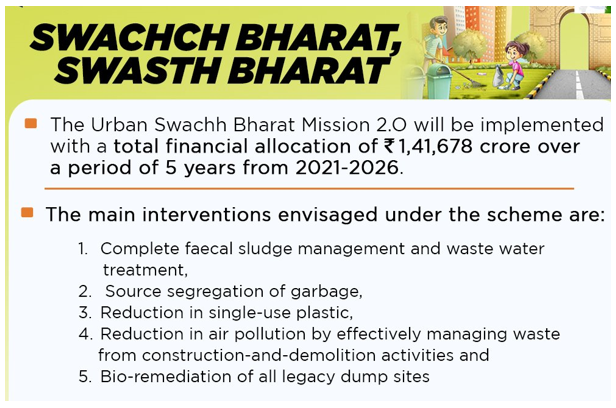- Courses
- GS Full Course 1 Year
- GS Full Course 2 Year
- GS Full Course 3 Year
- GS Full Course Till Selection
- Online Program
- GS Recorded Course
- NCERT (Recorded 500+ Hours)
- Polity Recorded Course
- Geography Recorded Course
- Economy Recorded Course
- AMAC Recorded Course
- Modern India, Post Independence & World History
- Environment Recoded Course
- Governance Recoded Course
- Science & Tech. Recoded Course
- International Relations and Internal Security Recorded Course
- Disaster Management Module Course
- Ethics Recoded Course
- Essay Recoded Course
- Current Affairs Recoded Course
- CSAT
- 5 LAYERED ARJUNA Mentorship
- Public Administration Optional
- ABOUT US
- OUR TOPPERS
- TEST SERIES
- FREE STUDY MATERIAL
- VIDEOS
- CONTACT US
SWACHH BHARAT MISSION-URBAN
SWACHH BHARAT MISSION-URBAN

Latest Context
A review-cum-workshop for evaluating and accelerating the planning and implementation of the second phase of Swachh Bharat Mission-Urban (SBM-U 2.0) across the country has been organized by the Ministry of Housing and Urban Affairs (MoHUA) organized recently.
Background: In light of the Joint Monitoring Program (JMP) Report on water, sanitation, and hygiene released by the World Health Organization and the United Nations Children's Fund (UNICEF) for the year 2022, the issue of open defecation has once again received attention. As per the report, approximately 17% of the total population in India continues to practice open defecation.
- Against this background, this review-cum-workshop has been organized by Ministry of Housing and Urban Affairs (MoHUA)
Key Highlights of the JMP Report
- Open Defecation Rate: It pointed out that 17% of the rural population in India still practices open defecation.
- Access to Basic Sanitation Facilities: A quarter of the rural population in India lacks access to "at least basic" sanitation facilities. Basic services are the ones with improved sanitation facilities that households do not share with others.
- Progress: It tracks progress since 2015 when the objectives for sanitation were set. As of 2015, about 41% of the rural population practised open defecation, which was reduced to 17% in 2022. As far as sanitation facilities are concerned. 51% of households had at least basic sanitation in 2015, which increased to 75% in 2022.
- Rate of Decline in Open Defecation: Annual average decline rate regarding open defecation in India is 3.39%. If this pace continues, achieving open defecation-free status would take around four to five years.
Swachh Bharat Mission-Urban
- Conception: on October 2, 2014, it was launched by the Ministry of Housing and Urban Affairs as a national campaign for promoting cleanliness, sanitation, and proper waste management in urban areas.
- Objective: Its objective is to make cities and towns across India clean and free from open defecation.
Swachh Bharat Mission-Urban 1.0
- Its goal is on achieving the target of making urban India Open Defecation Free (ODF) by extending access to toilets and promoting behavioral change.
- Its objective was fulfilled in achieving the target and 100% of urban India was declared ODF.
Swachh Bharat Mission-Urban 2.0 (2021-2026)
- It was announced in Budget 2021-22 as a continuation of SBM-U's first phase.
- The motto of the second phase of SBM-U is to go beyond ODF to ODF+, and ODF++, and make urban India garbage-free. Its emphasis is on sustainable sanitation practices, waste management, and the promotion of a circular economy.
Achievements 
-
Open Defecation Free (ODF)
- With all 4,715 Urban Local Bodies (ULBs) completely ODF, Urban India has become Open Defecation Free (ODF).
- 3,547 ULBs are ODF+ with functional and hygienic community and public toilets, and 1,191 ULBs are ODF++ with complete faecal sludge management.
- 14 cities are certified Water+, that requires the treatment of wastewater and its optimum reuse.
- Waste Processing: In the Indian context, it has gone up by over 4 times from 17% in 2014 to 75% in 2023, assisted through 100% door-to-door waste collection in 97% wards in addition to source separation of waste practised by citizens across almost 90% wards in all ULBs in the country.
- Garbage-Free Cities: In January 2018, Garbage Free Cities (GFC)-Star rating protocol was launched. It has increased from 56 cities in the first year to 445 cities to date, with an ambitious target of having at least 1,000 3-star GFC by October 2024.
Budgetary Provisions (2023 -24): It reinforced India's commitment to building a circular economy (an economic system based on reusing and regenerating materials or products) through an enhanced focus on the scientific management of dry and wet waste.
Open Defecation Free Status
- ODF: An area will be declared as ODF if, at any point of the day, not even a single person is found defecating in the open.
- ODF+: It is given when at any point of the day, not a single person is found defecating and/or urinating in the open, and all community and public toilets are functional and well-maintained.
- ODF++: When an area is already having the status of ODF+ and the faecal sludge/septage and sewage are safely managed and treated, with no discharging or dumping of untreated faecal sludge and sewage into the open drains, water bodies or areas, this status is granted.
Recommendations
- Pay attention to the importance of behavioral change to promote toilet usage over open defecation.
- Measuring and quantifying the behavioural shift towards using toilets to accurately ascertain ODF status.
- Pay attention to addressing the public health implications of open defecation by working towards its elimination.
- To maintain continuous monitoring and evaluation of sanitation practices to identify areas for improvement and ensure sustained progress.
- Review the ODF milestone in India based on the findings of the JMP report and take comprehensive measures to address open defecation and improve sanitation facilities.
Must Check: IAS Coaching Centre In Delhi
PLFS 2025: Monthly Jobs Data, Bigger Survey

